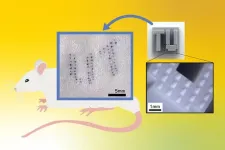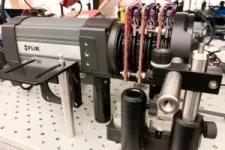A tiny tattoo for a tabby
2024-01-11
(Press-News.org) Tokyo, Japan – If you’ve ever taken a car trip through a rural area, you might already know that livestock, including cows and sheep, can be individually tracked using decidedly old-fashioned methods, such as ear tags or even branding marks. By contrast, many tech-savvy pet owners have opted to have their dog or cat “chipped” by having a radio frequency identification (RFID) permanently implanted under the skin. However, all these identification solutions leave something to be desired, as ear tags can become damaged or lost, while RFID chips require an invasive procedure to insert and specialized equipment to read.
In a study recently published in Scientific Reports, researchers from the Institute of Industrial Science, The University of Tokyo demonstrated an alternative “bio-tagging” method, in which a unique array of microneedles – with alphanumeric characters visible to the unaided eye - is directly inserted into the skin for permanent identification of animals. This approach relies on a patch of dissolvable microneedle arrays to deliver the dye molecules. “We feel that our method is a simpler, safer, and more humane way to label animals, and is versatile enough to be applied both in pets and industrial situations,” lead author of the study, Jongho Park says.
The researchers used microneedle array patches (MAPs), in which microneedle arrays, less than 1 mm long, are created in the form of a matrix from customized polydimethylsiloxane molds. By altering the molds, desired symbols can be tattooed into the animal, like the output of dot-matrix printers. The negative molds themselves can be made easily from positive 3D-printed resin plugs. “Our MAPs approach allows for a very large number of unique identifiers, and does not require much specialized training to apply,” says senior author, Beomjoon Kim.
Testing showed that the biotags remained clearly legible in the skin over a month after being stamped. This technique can be a useful tool for animal research and management, as well as potentially being extended biomedical applications and other areas such as flexible electronics integration.
###
The article, “Biotagging method for animal identification using dissolvable microneedle arrays prepared by customisable moulds,” was published in Scientific Reports at DOI: 10.1038/s41598-023-50343-6.
About Institute of Industrial Sciene, The University of Tokyo
The Institute of Industrial Science, The University of Tokyo (UTokyo-IIS) is one of the largest university-attached research institutes in Japan. UTokyo-IIS is comprised of over 120 research laboratories—each headed by a faculty member—and has over 1,200 members (approximately 400 staff and 800 students) actively engaged in education and research. Its activities cover almost all areas of engineering. Since its foundation in 1949, UTokyo-IIS has worked to bridge the huge gaps that exist between academic disciplines and real-world applications.
END
[Attachments] See images for this press release:


ELSE PRESS RELEASES FROM THIS DATE:
2024-01-11
JMIR Publications is pleased to announce that JMIR AI has passed the Scientific Quality Review by the US National Library of Medicine (NLM) for PubMed Central (PMC). This decision reflects the scientific and editorial quality of the journal. All articles published from 2022 onward will be found on PMC and PubMed after their technical evaluation.
Launched in 2022, JMIR AI is a new journal that focuses on the applications of artificial intelligence in health settings. This includes contemporary developments as well as historical ...
2024-01-11
WASHINGTON — Researchers have developed a new technology that uses meta-optical devices to perform thermal imaging. The approach provides richer information about imaged objects, which could broaden the use of thermal imaging in fields such as autonomous navigation, security, thermography, medical imaging and remote sensing.
“Our method overcomes the challenges of traditional spectral thermal imagers, which are often bulky and delicate due to their reliance on large filter wheels or interferometers,” said research team leader Zubin Jacob from ...
2024-01-11
WASHINGTON, Jan. 11, 2024 – The Heineman Foundation, American Institute of Physics, and American Astronomical Society are pleased to announce John E. Carlstrom as the winner of the 2024 Dannie Heineman Prize for Astrophysics.
Carlstrom was selected “for pioneering work on microwave interferometry and his leading role in the development of the South Pole Telescope, leading to the observations of clusters of galaxies through the Sunyaev-Zeldovich effect, B-Mode polarization in the cosmic microwave background and strong evidence for a flat universe, all of which changed the field for generations to come.”
“AIP congratulates ...
2024-01-11
PHILADELPHIA— Advancements in the study of two rare heart conditions—peripartum cardiomyopathy (PPCM), and dilated cardiomyopathy (DCM)—contributed by researchers at the Perelman School of Medicine at the University of Pennsylvania may serve as critical guides in future work toward developing therapies for the conditions. The lab of Zoltan Arany, MD, PhD, the Samuel Bellet Professor of Cardiology and a professor of Cell and Developmental Biology, published their findings this month in the New England Journal of Medicine (NEJM), adding to separate research they recently published in the Journal of Clinical ...
2024-01-11
FOR IMMEDIATE RELEASE
A Johns Hopkins Children’s Center study of children and youth with diabetes concludes that so-called autonomous artificial intelligence (AI) diabetic eye exams significantly increase completion rates of screenings designed to prevent potentially blinding diabetes eye diseases (DED). During the exam, pictures are taken of the backs of the eyes without the need to dilate them, and AI is used to provide an immediate result.
The study noted that the AI-driven technology used in the exams may close “care gaps” among racial and ethnic minority youth with diabetes, populations with historically higher rates of DED and less access to or adherence ...
2024-01-11
WASHINGTON—Endocrine-disrupting chemicals (EDCs) in plastics pose a serious threat to public health and cost the U.S. an estimated $250 billion in increased health care costs in 2018, according to new research published in the Journal of the Endocrine Society.
Plastics contain many hazardous, endocrine-disrupting chemicals that leach and contaminate humans and the environment. These chemicals disturb the body’s hormone systems and can cause cancer, diabetes, reproductive disorders, neurological impairments of developing fetuses and children, and death.
Potential options under discussion as part of a Global ...
2024-01-11
Scientists have long known that some viruses and bacteria begin infections by latching first onto sugar molecules on the surfaces of cells lining the sinuses and throat of mammals, including humans. Viral particles, for instance, can attach to these molecules, called sialic acids, or SAs, like keys fitting into locks.
Now, a new study in infant mice shows that keeping virus particles from attaching to SAs limits more than just the entry of influenza A viral infections, but also hinders their exit (shedding) and transmission from mouse to mouse. Such infections are the main cause of the seasonal flu that kills more than 36,000 Americans annually. While vaccines to guard ...
2024-01-11
What if scientists had developed a universal coronavirus vaccine in the years prior to 2020 so that it was available at the start of the COVID-19 pandemic? A universal coronavirus vaccine targets parts of the virus that are common to either many or all coronaviruses, thereby offering some degree of protection against a range of strains. A new study suggests if such a vaccine were available at the start of the pandemic, it could have saved millions of lives, prevented suffering, and saved billions of dollars in direct medical ...
2024-01-11
WASHINGTON—The popular TikTok trend of ‘hormone balancing’ has taken over the internet with claims to balance your hormones with holistic approaches alone, but medical experts question its legitimacy.
Endocrine Society expert Deena Adimoolam, M.D., will discuss ‘hormone balancing’ during the Society’s Virtual Science Writers Conference on January 24.
What: The Virtual Science Writers Conference will examine:
How hormones function and stay in balance
Common ...
2024-01-11
Florida’s 156-mile-long Indian River Lagoon (IRL) borders five different counties and has five inlets that connect the lagoon with the Atlantic Ocean. In recent years, this estuary has experienced numerous phytoplankton bloom events due to increased seasonal temperatures coupled with environmental impacts.
Algal blooms produce a myriad of small organic molecules, many of which can be toxic to humans and animals. Among these phycotoxin producers is Microcystis aeruginosa, a freshwater cyanobacterium, which can be found in the Southern IRL. Measurable amounts of microcystins have been found in nasal swabs ...
LAST 30 PRESS RELEASES:
[Press-News.org] A tiny tattoo for a tabby




